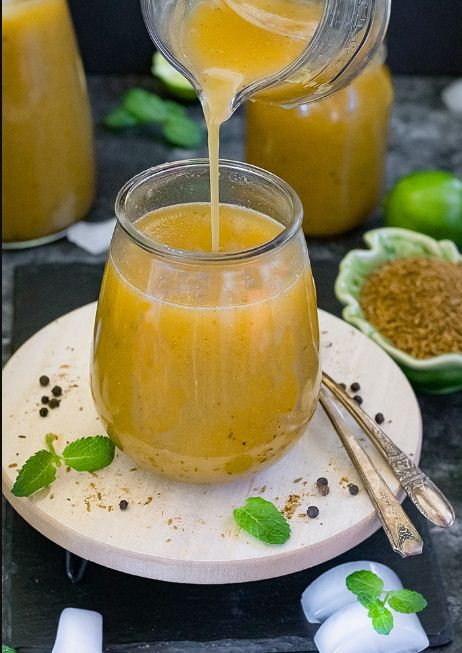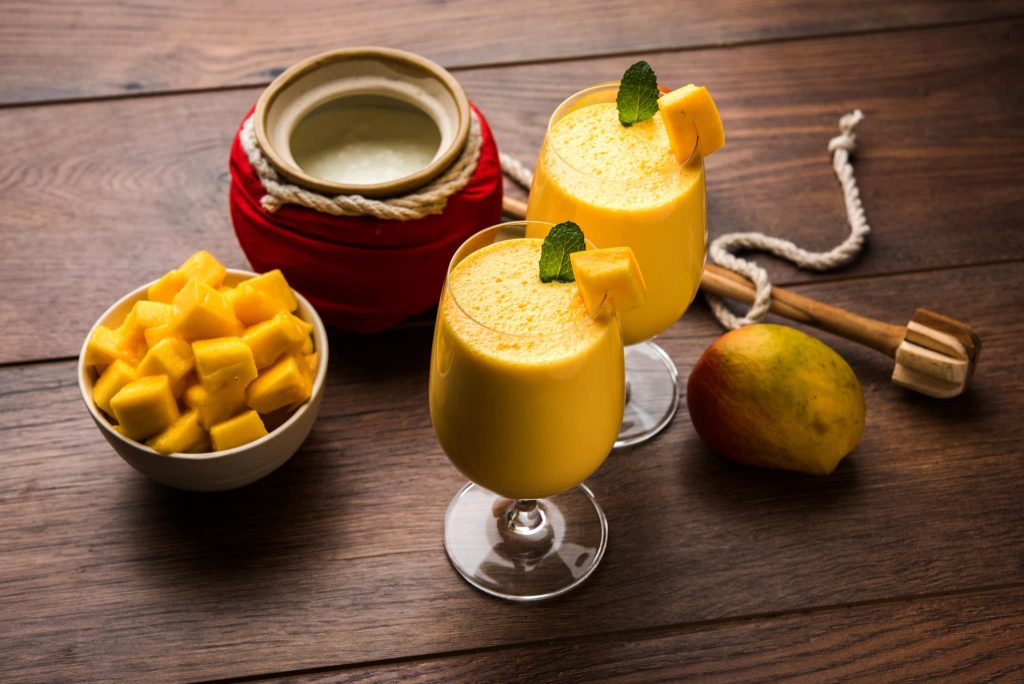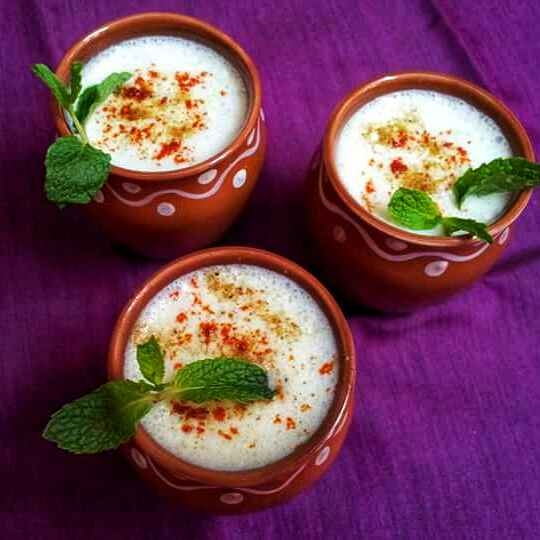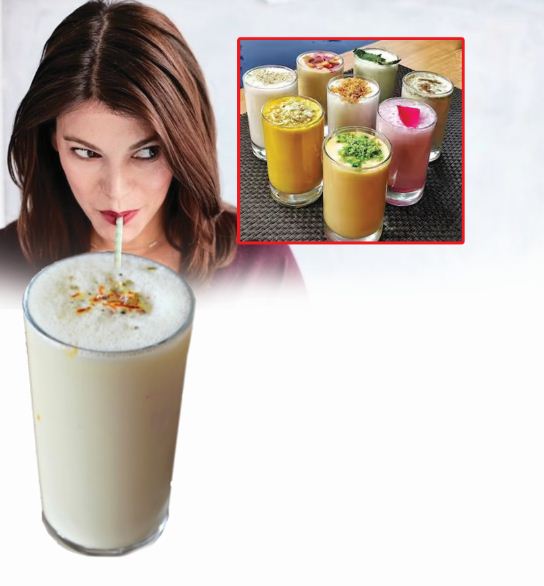By Foodie
Summer is here. The sun is scorching, throats are parched and the only thing you desire today is a cooling drink. Summers in India, especially in the northern parts, have always been cruel. So, from times immemorial, Indians have developed a number of natural cooling drinks that not only bring down your body temperature, but are also natural and healthy.
These drinks can easily be made at home, and are way more hygienic than the branded soft drinks that are sold at every street corner.
Here are some, and how you can make them at home easily. Enjoy with our family.
Aam Panna
Aam Panna is a popular summer drink across North India. A vegan and gluten-free, cooling drink made with green mango pulp, sugar, spices, and mint leaves.
It is commonly prepared during the summer when green mangoes are in abundance in the Indian subcontinent. It is also known as mango panha, Kairi ka apshola, or Kairi ka Panna.
This is an excellent thirst quencher that is sweet, tangy, and packed with Vitamin C. It is a vegan summer cooler made from unripe green mangoes. It is made when mangoes make their appearance in the hot Indian summers. Aam panna has a tangy, sweet taste with hints of cardamom, cumin & black salt. The addition of these spice powders and black salt not only brings in more flavours but also helps in the digestion.


It is called Aam Ka Panna or Kairi Ka Panna in North India, Aam Jhora in Madhya Pradesh, and Aam Pora Shorbot in West Bengal.
The mango panna may vary from light green to yellow depending upon the variety of the mango. The best season to enjoy panna is from April to June or during the peak of the summer.
How To Make It
Making aam ka panna – 2 ways
1. Steaming or boiling mango – In this method, the mangoes are cooked with water till they become soft and pulpy. You can steam, boil or pressure cook the mangoes. Later the pulp is removed and mixed with sugar, spices and salt. This boiling method for making aam panna is largely used in Maharashtra and Gujarat regions of India. The recipe presented here is adapted from my home science notes and in this recipe, we boil the mangoes.
2. Roasting mangoes – Here the mangoes are roasted on an open flame (fire stove or on charcoal) till the pulp is cooked and softens. The cooked mango pulp is collected and mixed with sugar, spices and salt. In the northern parts of India, aam panna is made with this roasting method.
- Ingredient
- 500 gram raw/green mango (kaccha aam/kairi)
- 1 Cup granulated white sugar or to taste
- 2 teaspoon black rock salt (kala namak) or Chaat Masala
- 2 teaspoon roasted cumin powder (jeera powder)
- ½ Cup fresh mint leaves
- 4 Cup water
- Tips & variations for making aam ka panna
- Use unripe green and tart mangoes. The mangoes have to be sour (khatta in Hindi).
- Avoid using mangoes which are fibrous.
- Mangoes can be cooked in a pressure cooker or a pan.
- It is better to not remove the mango peels, but you can remove them and then cook the mangoes.
- The ratio is 1:2 for mango pulp and sugar or jaggery. So measure the amount of mango pulp in a measuring cup before adding sugar or jaggery. If you get 1 cup of mango pulp, then add 2 cups of sugar.
- For a more sweet taste, you can always add more sugar or jaggery.
- Some mint leaves or coriander leaves can also be ground with the mango pulp in a mixer-grinder. Addition of any of these fresh herbs gives a different taste and flavor to aam panna and makes it green in color.
- How to make aam ka panna
- Rinse the raw mangoes in the water a couple of times. Place the mangoes in a 2-litre pressure cooker. Add 2 cups of water. You can also steam the mangoes in a steamer or a pot. You can remove the peels if you want and then pressure cook.
- Pressure cook for 2 whistles on medium flame or for about 12 to 14 minutes.
- When the pressure settles down on its own, then remove the lid. The mangoes would have become soft. The peels would also come out when the mangoes are cooked well.
- Gently pour the contents of the cooker in a fine strainer. Place a bowl underneath. Do not discard the water. Use this water to make aam panna. Do use a fine strainer so that the small pulp particles can be collected in the strainer and only the water is strained.
- Let the mangoes cool at room temperature. Place them in a bowl. After cooking raw mangoes, the peels come off easily.
- With a sharp-edged spoon or a knife, scrape and remove the cooked mango pulp directly in the bowl. Scrape from the peels also.
- Collect the cooked mango pulp in a bowl. Discard the peels.
- As a rule, always add double the amount of jaggery or sugar to the mango pulp. The ratio is 1:2 for mango pulp and jaggery, respectively. So, before adding sugar or jaggery measure the amount of mango pulp in a measuring cup. If you get 1 cup of mango pulp, then add 2 cups of sugar. I got about ¾ cup of mango pulp and thus added 1.5 cups sugar (325 grams).
- Now add the required amount of sugar or jiggery.
- Add 1 teaspoon cardamom powder, 1 teaspoon roasted cumin powder, 2 teaspoons black salt, ¼ teaspoon crushed black pepper or pepper powder. Add regular white salt or rock salt or Himalayan pink salt if you do not have black salt.
- Mix very well till the sugar granules are dissolved.
- You could also use a blender or hand churner to blend the aam panna.
- You can keep at room temperature for some minutes till all sugar granules are dissolved. The aam panna concentrate is ready.
- Pour the aam panna concentrate in a clean glass bottle or jar. Store the bottle or jar containing the concentrate in the fridge.
- For making aam panna drink, add 2 to 3 tablespoons of aam panna concentrate in a glass.
- Add the water in which the mangoes were cooked or chilled water. You can also add water at room temperature. You can even add a bit of lemon juice at this step.
- Stir and mix well.
- Serve aam panna. You can also add some ice cubes while serving. You can even garnish with some mint leaves or coriander leaves or lemon wedges.
Health benefits of aam panna:
- It prevents the body from getting heat stroke and keeps it cool.
- Raw mangoes are rich in vitamin c and iron, plus the addition of jaggery also gives an iron boost.
- It helps in preventing stomach problems in the summers.
- Good for digestion.
Bel ka sharbat
Bel ka sharbat is one of the most favoured healthy energy drinks during summers in India. Bael ka Sharbat is the best beverage during the scorching heat of the summers, especially in Northern India. The cooling effect of the juice helps us to maintain our body temperature even when the mercury is soaring, bel juice or Wood Apple Fruit is one of the most loved summer drinks in India. It not only provides a cooling effect to the body but also has a nutritional quotient as well. The cooling effect of the juice helps us to maintain our body temperature even when the mercury is soaring. If you haven’t tried this recipe yet, you are missing out on something great. But it’s never too late to try good things in life. - Bel consists of vitamin C, beta carotene and some vitamin B that helps fight common diseases and viral infections. Bel naturally fights viral and bacterial infections, can reduce inflammation, and is considered a good cure for a number of diseases.
- It can relieve constipation, diarrhea, indigestion, ulcers, piles, and respiratory problems. That apart, it also helps the body fight against cancer, diabetes, and sexual dysfunctions.
- When it comes to taste and texture, the hard-shelled bel delivers like no other fruit can. The pulp is soft and can be turned into a smooth juice. The peachy aroma helps the senses further.
Benefits - Best for Stomach: Consumption of bel juice is considered very beneficial for the stomach. Because drinking it strengthens the digestive system. Along with this, the complaint of constipation is also removed.
- Best for diabetes patients: The branches and truck of the bel tree contain Feronia gum that reduces the elevated blood glucose level. It is a part of essential Ayurvedic treatment for diabetes and in the long run, can also cure the severity of this disease.
- Boosts immunity: Wood apple is the powerhouse of vitamin C which is a strong antioxidant that boosts immunity and provides relief from common cold, sinus, headache, eye and ear pain. It is also effective in fighting chronic diseases and reduces the risk of high blood pressure. Wood apple is also rich in anti-inflammatory properties helping reduce the risks of cardiovascular diseases. Having wood apples during monsoons will help in preventing infections due to bacteria and viruses.
- Good for blood purification: It is known as a powerful blood purifying agent and helps in the elimination of toxins from the system. It is a natural detoxifying agent and thus, prevents kidney and liver dysfunctions. It also helps in fighting with infections and skin diseases which are common in monsoons. Wood apples are known to heal and prevent acne and skin related issues.


- Ingredients
- 3 small to medium sized bel fruit (Bengal quince or stone apple or wood apple)
- 3 to 3.5 cups chilled water
- 12 tablespoons jaggery or add as required
- ⅓ teaspoon cardamom powder (choti elaichi powder)
- ⅓ teaspoon of roasted cumin powder (bhuna jeera powder)
- 2 pinches black salt
- How to make
- First take the bel fruits and with a rolling pin (belan) hit all around.
- Use 3 medium sized bel fruits.
- You will see the outer hard shell cracking. Open the hard shell and you will see a brown colored pulp.
- With a spoon, scoop out the soft pulp.
- Add the scooped soft pulp in a bowl.
- Then add 1 cup of water.
- Soak this mixture for 20 minutes.
- After 20 minutes, with a veggie masher, mash the pulp. Mash very well.
- Then using a strainer, strain the mashed mixture in parts. Also overall add about ½ to ¾ cup water while straining.
- With a spoon stir so that the mixture is strained well.
- Once the mixture is strained, then add 12 tablespoons of jaggery. You can also add sugar. Both jaggery and water can be adjusted as per your requirements.
- Then add roasted cumin powder, cardamom powder and 2 pinches of black salt.
- Mix very well.
- Pour in glasses and serve bel sherbet. You can make the bel sherbet thin or thick by adding more or less water.
Lassi
Lassis are an ancient drink originating from the Punjab region. A lassi is a blended drink with dahl (yogurt), water, spices and sometimes fruit. It originated sometime around 1000 BC and was said to have Ayurvedic healing properties, calming the stomach and the mind.


Lassi is a cooling, refreshing, probiotic drink perfect for the warm summer months. Popular in Punjab and North India, there are many variations of a lassi recipe, including mango lassi, dry fruits lassi, and malai lassi.
There are many variations of this drink. Lassi is made both sweet and salty. Lassi is also a probiotic drink as obviously it is made from curd or yogurt which has gut friendly bacteria in it.
It is also made with a combination of fruits and yogurt. Fruity variations of lassi – Mango Lassi and Strawberry Lassi.
There are different types of lassis:
1. Mango Lassi: Mango Lassi is another popular version which has sweet mangoes blended with yogurt.
Ingredients
- 1 cup mango pulp 250 ml, use fresh if possible from 2-3 sweet
- mangoes else can use canned mango pulp
- 1 cup yogurt 240 ml, plain whole milk yogurt
- 1/2 cup milk (cold) or cold water, to thin out the lassi
- 1-2 tablespoons sugar or adjust to taste
- 1/4 teaspoon cardamom powder
- pistachios to garnish, optional
- saffron strands to garnish, optional.
How to make
1. To a large bowl, add 1 cup fresh mango pulp. I got the pulp from 2
large sweet mangoes which I blended in a blender to make it smooth.
You can use canned mango pulp if you can’t find sweet mangoes.
2. To the same bowl, now add yogurt. I have used plain whole milk yogurt here.
3. Now add cold milk (or water). I add this to thin out the lassi a bit. Also add the sugar and the cardamom powder.
4. Blend everything until well combined. I used an immersion blender.
5. Pour the mango lassi into serving glasses and chill before serving. You may garnish with pistachios, saffron strands before serving.
Salted lassi : The salted version of lassi is a contrasting variation to the popular sweet lassi. This salty lassi is spiced and flavored with black salt, roasted cumin powder and garnished with mint leaves.
A variation to this lassi is to blend some mint leaves with yogurt and you have a nice refreshing Mint lassi. Some people also make this lassi simply with yogurt, water and salt.


Ingredients
- 2.5 cups Curd – cold and fresh (yogurt)
- 1 cup water – cold or at room temperature
- 1 teaspoon black salt or regular salt or edible rock salt, as required
- 1.5 teaspoons roasted cumin powder
- 6 to 7 mint leaves.
How to make
- Take the curd and water in a bowl or pan. Season with salt and roasted cumin powder.
- To make your own roasted ground cumin, dry roast cumin seeds in a small skillet or frying pan until fragrant. Then crush in a mortar-pestle or grind finely in a spice-grinder.
- With a wired whisk, blend everything well till smooth. A blender or an immersion blender also works.
- Pour the salted lassi in glasses. Garnish with mint leaves. You can add a few ice cubes if you like. If you wish to avoid the ice cubes, then make lassi with chilled yogurt and cold water.





















